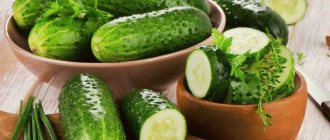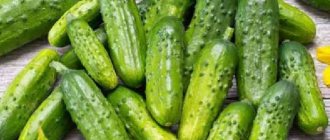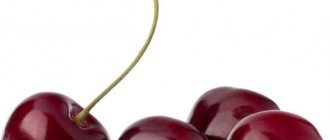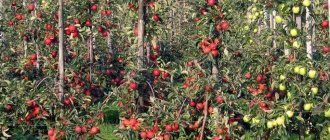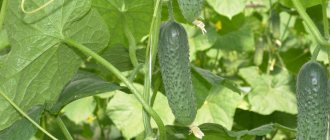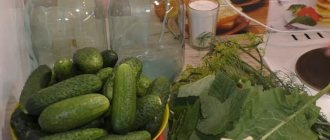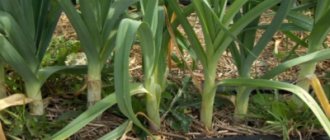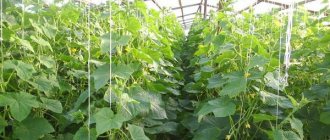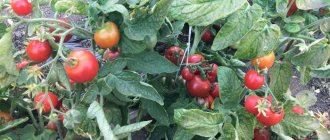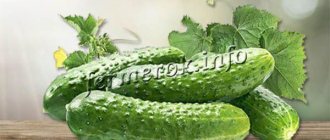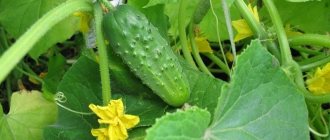How to make the right choice
To make it easier to navigate the huge variety, it is recommended to select varieties:
- zoned for your region;
- that interest you (for a greenhouse or vegetable garden);
- taking into account the purpose (for salads, pickling, universal) and ripening period;
- resistant to low temperatures, diseases and pests.
Then, according to the selected varieties, you should study information about yield, size, weight and taste, and then finally decide on your choice.
In order for cucumbers to delight you with high yields and a delicate taste, it is recommended to consider a few more tips:
- it is advisable to purchase hybrids;
- it is better to buy seed sold by domestic producers;
- You should purchase from stores where seeds are sold;
- carefully study the label, which provides information about the date of manufacture and expiration date.
The best self-pollinating cucumber hybrids for open ground
Such crops do not require special care. Plants need to be provided with regular watering, fertilized on time, and weeds that appear nearby should be destroyed. In one flower of such crops there are pistils and stamens. Cucumbers pollinate on their own, without insects, creating fruits with seeds.
Early crops have juicy and tender pulp. Late self-pollinating varieties are denser and are ideal for preservation. Rating of the best varieties: Herman, Claudia, Alliance, Orpheus, Zador, Connie, Muromets, Masha, Gerda; gherkins - Alex, Melody, Opera.
Herman F1
Hybrid early variety. Cucumbers are tender, without bitterness. Suitable for vegetable salads and pickling. Ripe vegetables reach 12 centimeters in length and weigh 95 grams. Up to 9 fruits can form in one ovary. The crop rarely suffers from late blight.
Alliance F1
Hybrid, ripens in 50 days. The culture bears fruit abundantly. A ripe cucumber has a length of 15 centimeters and a weight of 125 grams. One bunch can grow 6 fruits. It is advisable to germinate the seeds before planting. An ideal variety for preservation.
What varieties are grown in the Moscow region
According to reviews, the best varieties of cucumbers for the Moscow region:
- April;
- Aquarius;
- Bush;
- Masha;
- Goosebumps.
According to ripening period
All varieties of cucumbers, depending on the ripening period, are divided into early, middle and late. It should be noted that in the northern regions you need to sow early vegetables, but for the southern regions any vegetables will do .
Early ripening
You can enjoy the taste of cucumbers already 30-40 days after germination.
Particularly popular among gardeners are:
- Altai early;
- Cupid (ultra-early);
- April;
- Pinocchio;
- Hermann;
- Zozulya;
- Cascade;
- Connie;
- Competitor;
- Courage;
- May;
- Tom Thumb;
- A summer resident's dream;
- Moscow dude;
- Muromsky 36;
- Finger;
- Moscow Nights;
- Five Stars;
- fontanel;
- Cornucopia;
- Company's secret;
- Khutorok;
- Gypsy;
- Ecole.
Mid-season
Maturity occurs in 40-55 days.
The best mid-season varieties:
- Alliance;
- Athlete;
- Babayka;
- White angel;
- Zozulya;
- Libelle;
- Nezhinsky;
- Topolek;
- Unity;
- Solar;
- Son of the regiment;
- Claudia;
- Connie;
- Competitor;
- Kuzya;
- Lohengrin;
- Picas;
- Raphael;
- fontanel;
- Svyatogor;
- Phoenix Plus;
- French size;
- Ecole.
Late ripening
They ripen in 60-80 days.
Received good recommendations:
- Aquarius;
- Hercules;
- Nezhinsky;
- Winner;
- Solar;
- Phoenix;
- Drop;
- Crunch.
It should be noted that the time it takes before ripening may vary depending on the quality of the seeds, planting location (greenhouse or open ground), soil composition, temperature, and watering.
By yield
Of course, every gardener strives to plant vegetables that would produce the maximum yield. To get 10-20 kilograms of cucumbers per square meter, it is recommended to purchase the following varieties:
- Amur;
- White Night;
- Pinocchio;
- Viva;
- Hercules;
- Summer resident;
- Dasha;
- Noble;
- Zozulya;
- Emelya;
- Chinese climbing;
- Claudia;
- Corinto;
- Sturdy;
- Bush;
- Lohengrin;
- Unwashed 40;
- Winner;
- Cellar (the most productive);
- Cornucopia;
- fontanel;
- Svyatogor;
- Solar;
- Phoenix;
- Crunch.
By method of use
Depending on the purpose of use, cucumber varieties are divided into salad varieties, intended for pickling and preservation, and universal ones.
Salad
The fruits are distinguished by their large size, beautiful appearance and sweet taste. They have thin skin and a smooth surface. If you pickle such cucumbers, they become too soft.
The best varieties for salads are:
- Bazaar;
- Bukhara;
- Hercules;
- Zozulya;
- Kochubey;
- Lohengrin;
- Martha;
- Svyatogor;
- Tamerlane.
Zozulya.
Salting
The fruits have a dense peel covered with thorns. After salting they do not lose their elasticity.
An excellent choice for salted consumption would be:
- Hermann;
- Zyatek;
- Elegant;
- Cascade;
- Kuzya;
- Libelle;
- Tom Thumb;
- Masha;
- Monastic;
- Goosebumps;
- Nezhinsky;
- Fontana.
For preservation
For canning, small-sized greens are selected that crunch when bitten.
According to reviews, it is best to roll in jars:
- Fabulous;
- Erofey;
- Elegant;
- Cascade;
- Competitor;
- Kuzya;
- Movir;
- Muromsky;
- Nezhinsky;
- Ecole.
Erofey.
Universal
Cucumbers of these varieties can be eaten fresh, pickled, or canned. But their productivity is low.
Universal varieties include:
- Stork;
- Amur;
- Babayka;
- Coastal;
- Blagovest;
- East;
- Hermann;
- Connie;
- Courage;
- Bush;
- Libelle;
- Tom Thumb;
- A summer resident's dream;
- Moravian gherkin;
- Five Stars;
- Cornucopia;
- Phoenix 640;
- French size;
- Ecole.
For open ground
The following varieties are ideal for growing cucumbers in open ground in the Moscow region:
- parthenocarpic, since bees do not fly in cool and cloudy weather;
- early;
- resistant to sudden temperature changes;
- capable of producing high yields with a lack of light and heat;
- resistant to pests and diseases.
The best cucumbers for open ground for the Moscow region:
- Stork;
- Alex;
- Altai early;
- Angelina;
- Annushka;
- Atlantis;
- Ajax;
- Fabulous;
- VIR 505;
- Vyaznikovsky;
- Snowstorm;
- Hermann;
- Darling;
- Baby Crane;
- Claudia;
- Competitor;
- Libelle;
- Masha;
- Ringtones;
- Blizzard;
- MOVIR;
- Nezhinsky;
- Opera;
- Petersburg Express;
- Cellar;
- By magic;
- fontanel;
- Santana;
- State Farm;
- Nightingale;
- Harvest 86;
- Farmer.
Mid-season cucumber varieties for the Moscow region
Mid-season cucumber varieties ripen in about 45-50 days. Sometimes, for convenience, medium-late species are separated separately, and they can already ripen for up to 60 days.
fontanel
A mid-season variety that is valued primarily for its increased resistance to fungus and diseases. Cucumbers are not bitter at all, because this property was eradicated during selection.
Photo: sadoviycentr.ru
Son of the regiment
Small gherkins do not turn yellow or overgrow, so they are often grown on an industrial scale. The fruits are very smooth and neat, universal purpose.
Photo: artzakaz.pro
Madam
Beautiful cylindrical cucumbers grow on average up to 85 g. The variety is resistant to rot and powdery mildew, bears fruit intensively, but needs pinching.
Photo: ikd.ru
Picas
A powerful, tall hybrid is distinguished by high yield, both early and overall. Cucumbers are tasty, oblong, with almost smooth skin and weighing up to 210 g.
Photo: spb.procvetok.ru
Libelle
A short-fruited, universal variety suitable for canning and used fresh. The fruits do not turn yellow or taste bitter, are evenly covered with small tubercles and grow up to 12 cm.
Photo: kozalavka.ru
Floribunda rose: the best varieties for the Moscow region
Preparatory work
In order for cucumbers to feel comfortable and produce high yields, it is necessary to prepare a plot for them (best in the fall):
- choose a place well lit by the sun and protected from northern winds;
- dig up the soil and apply fertilizer;
- arrange a raised bed;
- Move the site to a new location every 2-3 years.
Soil preparation
To make a high bed, you need:
- According to the size of the proposed bed, dig a hole to a depth of 20-25 centimeters.
- Fence the area around the perimeter with slate or boards to a height of 20-30 centimeters.
- Fill the box with soil prepared from black soil, humus, peat and sand, taken in a ratio of 3:1:1:1. Add 1-2 kilograms of wood ash and 50-60 grams of superphosphate per square meter.
But it is better to prepare a warm bed, for which 3 layers 10-15 centimeters thick are placed in a box:
- the first layer is sunflower or corn stalks, tree branches, boards;
- second layer - shavings, wood chips, small twigs;
- third layer - leaves, hay, sawdust.
Cover the top with a layer of 5-7 centimeters of black soil. The bed is well moistened. It is advisable to add products that contain soil bacteria.
Seed preparation
Manufacturers often sell seeds already prepared for sowing. They are covered with a bright shell, which contains nutrients.
If you take untreated seeds for sowing, then they need to be prepared. First, unusable seeds should be discarded. To do this, the seed is placed in salted water (a teaspoon of salt is needed per glass of water) for half an hour. During this time, seeds unsuitable for sowing will rise to the surface, and high-quality seed will sink to the bottom.
To increase yield, you can add methylene blue (0.3 grams of powder per liter of water) when soaking. For disinfection, seed material is treated with a solution of potassium permanganate.
To speed up germination, the seeds are soaked and kept warm until they hatch.
The right choice: what to look for
Cucumbers have been grown in this region for a long time, preparing whole barrels of delicious pickles for the winter. Modern summer residents have at their disposal a huge assortment of varieties that differ in ripening time, purpose, and appearance. The choice is individual, but there are general recommendations:
- select zoned varieties and hybrids adapted to the changeable climate of the Moscow region;
- take into account the purpose of the fruit (salad, for preservation and marinades, universal type);
- take into account the timing of ripening of greens.
For a short summer period, early and mid-ripening cucumbers are suitable (for greenhouses); for open ground - mid-ripening cucumbers. Late-ripening hybrids bear fruit well on the ridges, the fruits of which are used in various winter harvests. It is necessary to take into account the growing conditions - in open-air beds, under temporary shelters, in greenhouses. For shelters, the best cucumbers are self-pollinating and parthenocarpic, which do not require pollinating insects. It is better to plant bee-pollinated varieties and hybrid forms in OG, planting cucumbers with pollinators to increase the yield.
Growing seedlings
To sow seeds for seedlings, mix humus, peat, turf soil and river sand in equal proportions. For each bucket of prepared soil, add 500 grams of wood ash and 50 grams of superphosphate. You can also purchase ready-made soil at a specialized store.
It should be taken into account that cucumbers are very difficult to tolerate picking and transplanting. Therefore, it is better to sow seeds in peat pots or tablets. If seedlings are grown in plastic cups, then they are transplanted using the transshipment method.
The optimal volume of cups for seedlings is 200-250 milliliters. Small holes are made in their bottom for drainage. Sow 2-3 seeds in one cup, deepening them by 1-2 centimeters. The containers are covered with film until germination.
Seedlings must be provided with lighting for 12-14 hours daily. If there is insufficient lighting, the seedlings will stretch out and die. It is best to purchase phytolamps that emit light waves in the spectrum required by plants. But in their absence, you can use fluorescent lamps or “housekeepers”.
For irrigation, use settled water at room temperature, preferably rain or melt water. You can’t water the soil too much, but you shouldn’t let it dry out either. Typically, seedlings are watered 2 times a week. The soil is loosened periodically.
If seedlings are planted in properly prepared soil, then they do not need fertilizing.
A few days before planting in open ground, plants need to be hardened off. To do this, they are taken outside.
How to properly feed cucumber crops
To get a rich harvest, you need to regularly feed the plant. Once a week will be enough. Cucumbers also need watering. A composition of bird droppings at a ratio of 1:5 or mullein at a ratio of 1:4 is excellent for fertilizing. A liter of this composition is diluted with 10 liters of water. Up to 2 liters of fertilizer are needed per bush.
Bird droppings
As an alternative, you can use Agricola, Effecton, and Energen fertilizers. You can choose any drug or alternate them. Watering is carried out with warm water 3 times a week.
Important! To avoid infecting the plant with powdery mildew, it should be watered under the root.
In order for bees to pollinate cucumber flowers, you can attract them using a folk method. Take bait syrup from 500 ml of water and 1 tbsp. l. chalk. Spray the prepared product over the area where the cucumbers grow.
Landing
Planting can be done in rows or in a square-cluster method, which is more preferable. Seeds are planted in the soil to a depth of 3-5 centimeters.
With the square-nest method , holes for plants with short vines are made at a distance of 70 centimeters, and with long ones - at a distance of 90 centimeters. Place 2-3 seeds in one hole.
With the trellis method , a two-line diagram is used. Make 2 rows at a distance of 40-50 centimeters, leaving a half-meter passage between them. In a row, plants are planted at a distance of 20-40 centimeters.
If you grew seedlings, then they need to be planted in the ground at the age of 25-30 days. It is advisable to choose cloudy weather for planting. If the days are sunny, then planting work should begin in the evening. A handful of ash or humus is placed in each hole. After planting, the bushes are well watered.
Transplanting.
When to plant
There is no exact date for sowing cucumbers. The landing time is determined by weather conditions. The air should warm up to 18°C (night temperature should not fall below 8 degrees), and the soil - up to 10.
In the Moscow region, the optimal time for planting is usually no earlier than mid-April.
Sowing seeds for seedlings is carried out at the end of March. The lunar calendar 2022 will help you choose the optimal dates for sowing seeds and planting seedlings.
Optimal varieties
While in the southern regions it is possible to grow almost all varieties and hybrids of cucumbers, taking into account only their drought resistance, not all are suitable for the Moscow region - especially for representatives with late ripening periods, as well as those sensitive to daily temperature changes. However, if cultivation techniques are followed, many varieties demonstrate maximum yield even in difficult weather conditions.
"Hermann"
Determinate hybrid of the first generation with early ripening and excellent taste, devoid of bitterness. It was bred as parthenocarpic, not requiring insects for pollination, which is very important in the rainy conditions of the Moscow region. The fruits are even and do not tend to overgrow even if removed from the vine too late. The average yield of marketable fruits is 13-15 kg/m2.
"Farmer"
Mid-season hybrid with unlimited growth. With vertical cultivation on a high trellis (2 m) and careful care, you can harvest up to 25 kg. Fruiting occurs on the 50-55th day and lasts with timely harvesting of greens until frost. Pollination by bees is noted as a disadvantage. The hybrid is resistant to many specialized diseases.
For your information! Mid-season varieties in the Moscow region are often grown in seedlings, which allows for the production of the first greens to be accelerated and the fruiting phase to be extended.
"Shorty"
Bush, early ripening hybrid. The plants are medium-sized with strong shoots and large foliage. After flowering, small, short green flowers with small tubercles throughout the peel form on the bush. The flesh is dense and crispy. The weight of commercially grown cucumbers is 50-65 g. “Shorty” is perfect for whole-fruit preservation. Productivity – 3-4 kg/m2.
"Summer resident"
Bee-pollinated, early hybrid with unlimited growth. The type of fruit formation is bunched. The fruits are 10 cm long and weigh about 90 g and have an excellent taste. Universal purpose: suitable for both salads and canning. The variety prefers fertile, loose soil with good aeration. Additional watering allows you to increase the yield up to 20 kg/m2.
"Mother-in-law's dessert"
Ultra-early ripening parthenocarpic hybrid. The first greens, which form in bunches in the axils of the leaves, are removed already on the 35th day after emergence. The weight of fruits of regular shape is 90-100 g. The hybrid is immune to powdery mildew and root rot, therefore it grows well in conditions of high humidity and frequent precipitation. Productivity – 10-15 kg/m2.
Care
It is not enough to simply plant high-yielding varieties. In order for them to fully demonstrate their properties, it is necessary to create appropriate conditions for them.
Watering
Cucumbers belong to moisture-loving crops. Therefore, the bushes need to be provided with abundant watering, the frequency of which is reduced before flowering. During this period, even slight wilting of the leaves is acceptable, which activates the formation of ovaries. Then the frequency of watering is resumed.
You can spray the bushes from above, which will increase air humidity and remove dust from the leaves. Spraying is best done in the morning. Per square meter you will need 5-10 liters of water.
Top dressing
Cucumber bushes need to be fertilized regularly, alternating mineral and organic fertilizers. Watering with mullein diluted with water in a ratio of 1:8 gives excellent results. For mineral fertilizing, take ammonium nitrate, superphosphate and potassium salt in a ratio of 3:2:1.
Solutions of baking soda (50 grams), boric acid (0.5 grams), and iodine (2 grams) have proven themselves to be good foliar fertilizers. The substances are dissolved an hour before spraying in a bucket of water.
Garter
It is best to grow high-yielding cucumbers for open ground in the Moscow region using a trellis method. In this case, the stems will weave upward along the support, which will prevent them from becoming tangled and breaking, improving lighting and ventilation, accelerating the ripening of greens, reducing the risk of diseases, making care and harvesting easier, and saving space.
To prepare the trellis, you can use several methods:
- Hammer an individual peg for each bush, which is not entirely convenient.
- Plant corn near the cucumbers, the stems of which will become a natural support for the cucumber vines.
- Purchase a special plastic mesh. In this case, poles are installed at the edge of each row, between which a mesh is stretched, along which it will be convenient for the plants to weave.
- Along the edges of the rows, pillars are fixed to which a rigid crossbar is attached. Cords are passed down from the crossbar, to which the lashes are tied.
Mesh garter.
Mulching
Mulching will help retain moisture in the soil and inhibit the growth of weeds. Peat, sawdust, and straw are used as mulch (its thickness is 6-8 centimeters).
Weeding and loosening
Watering and rain compact the soil, making it difficult for air and nutrients to reach the root system. Therefore, periodically you need to loosen the soil with a pitchfork or rake, trying not to damage the tender shoots.
When weeds appear, they are pulled out by hand.
Pinching and pinching
In order for the bushes to grow well and the number of female flowers and, consequently, ovaries to increase, the main shoot is pinched after the formation of the second leaf. Then they also pinch the side stems. You can leave one or two shoots on the bushes.
Diseases and pests
Vegetables often become infected with fungal infections, which multiply most actively at high humidity and temperature. Most often, cucumbers suffer from white rot, powdery mildew, and brown spot. To prevent infection, it is recommended to carry out preventive treatments regularly.
Cucumbers are often attacked by pests: aphids, spider mites, spider beetles, and earwigs. When they appear, the bushes are sprayed with insecticides or folk remedies.
Where and how best do cucumbers grow?
Their seeds are sown next to cabbage and peas in the ground, but should not be planted near potatoes. It is recommended to plant beans or corn on all sides of the beds with cucumber bushes. Beans will protect young plants, and corn will protect the grown crop.
Beans tolerate cold weather well; they are planted even earlier than cucumbers in 2 rows, keeping a distance of 0.15 m between rows. Corn is planted at the same time as cucumbers - in 2 rows. It is even better to sow beans and corn across the direction of the winds.
To understand how to grow a crop, you need to know that seeds are sown in the place where tomatoes, peas, peppers, cabbage, and onions previously grew.
To grow cucumbers, they should never be planted after beans or carrots, as these crops suffer from white rot, which also affects cucumbers.
Nuances of cultivation
To maintain high yields, it is recommended to update varieties every 3-5 years.
In the open ground
To attract pollinators, coriander is sown between rows or the bushes are sprayed with honey syrup. Many gardeners prefer to sow self-pollinating cucumbers for open ground.
In the greenhouse
When growing cucumbers in a greenhouse, you will need to monitor humidity and ventilate.
The daytime temperature during fruiting should be 25-30 degrees, and the night temperature should be 20-23. Humidity should be kept at 90%.
To increase humidity, containers with water are placed in the greenhouse and the bushes are sprayed. To reduce humidity and temperature, the greenhouse is ventilated.
Formation of self-pollinating cucumbers.
The best varieties of cucumbers for greenhouses in the Moscow region
In greenhouses you can grow both large juicy cucumbers and small crispy gherkins. Here are the best varieties for preservation, because under stable conditions they grow identical and beautiful.
Masha
A very productive early variety that can be harvested after 36 days. The fruits are small, a little prickly and slightly bitter, but they are ideal for canning and pickling.
Photo: prolife.ru.com
Murashka
An excellent self-pollinating variety with short, lumpy salad fruits that are easy to recognize. In greenhouse conditions in the Moscow region, it is easy to collect up to 7 kg of cucumbers from a bush.
Photo: ok.ru
Benefit
Benefis fruits have a very expressive and fresh taste without any bitterness. The variety is resistant to fungus and rot, is completely unpretentious and is suitable even for beginners.
Photo: vistapointe.net
Elegant
An early greenhouse variety is best suited for salads, but is sometimes used for canning. Cucumbers are almost smooth, with small tubercles.
Photo: sadoviycentr.ru
Kuzya
Another hybrid with small fruits that grow to a maximum of 9 cm. This is a classic salad variety and at the same time one of the best for canning.
Photo: kartoska.ru
The best varieties of tomatoes for the Moscow region: photos, names and descriptions (catalogue)
